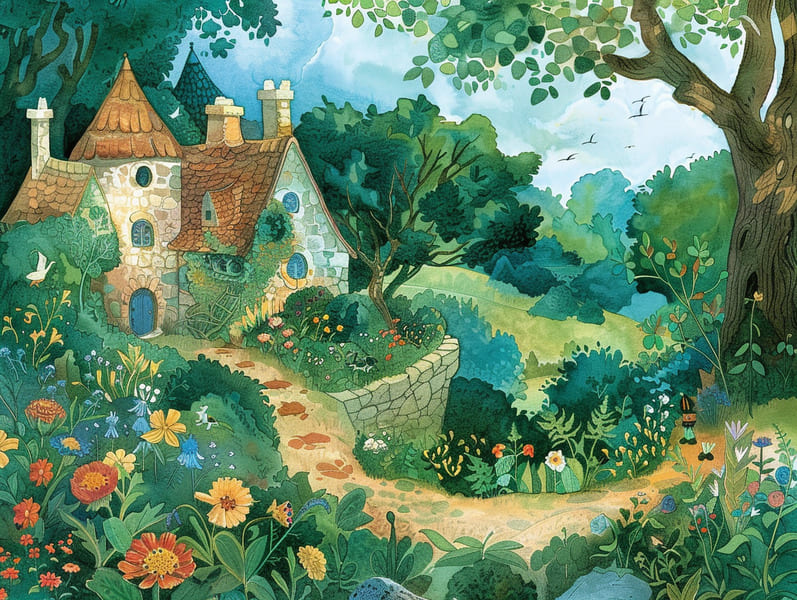The Evolution of Legendary Fairy Tales and the Unfading Appeal.
The Evolution of Legendary Fairy Tales and the Unfading Appeal.
Blog Article

Fairy tales for kids have old origins. These tales have been relayed from one generation to the next well before they were ever transcribed. They originated from a variety of cultures, including African traditions. They were initially transmitted among mature audiences, often carrying themes and messages related to the societal norms and beliefs of the time.
The famous Grimm duo, the two Grimm brothers, were among the first to collect and release many of these beloved fairy tales. Their compilation, "Grimm's Children's Stories," included narratives like "Cinderella," "Little Brother and Little Sister," and "The True Story of Snow White," which have since become cornerstones in the world of traditional fairy tales. Similarly, Andersen's imaginative narratives, such as "The Sea Maid," and "The Ugly Duckling," have captured hearts worldwide, securing their place in the pantheon of beloved fairy tales.
Though they are centuries old, fairy tales remain as applicable as ever, especially as nighttime stories for kids. These whimsical stories are now available in diverse formats, including vividly illustrated books, magical animations, and online fairy tales.
Their unwavering allure can be linked to several enchanting factors:
Significant Morals: Timeless fairy tales often offer important moral lessons. Narratives like "The Wolf and the Liar" teach the value of integrity, while "The Story of the Tortoise and the Hare" stress the values of persistence and unpretentiousness. These tales offer kids clear distinctions between right and wrong, shaping their moral compass in a gentle yet profound way.
Compassion and Insight: Traditional fairy tales frequently feature individuals facing obstacles and hardships, inspiring readers to comprehend with their struggles and celebrate their triumphs. For instance, "Beauty and Her Beast" points out the importance of seeing beyond the surface to know the true essence of a character, cultivating warmth and insight.
Cultural Awareness: Many classic fairy tales are deeply ingrained in the cultural contexts from which they came. Delving into these tales can provide intriguing perspectives into different social structures, developing a sense of cultural awareness and acknowledgment.
Fantasy and Innovation: The extraordinary elements in ancient fairy tales—mythical creatures—unleash children’s visions and dreams. These narratives lead readers to enchanted realms, motivating inventive thinking and a sense of amazement that stays a lifetime.
Timeless fairy tales are not only magical but also enlightening. They work as fascinating tools in nurturing various intellectual and emotional capacities in little ones. When classic fairy tales are told out loud, they enhance communication skills by teaching new vocabulary and complicated sentence structures. This practice also boosts auditory skills and attention span, as little ones keep up with the story, anxious to see what happens next.
Furthermore, analyzing the themes and characters of timeless fairy tales can develop thought processes and reasoning skills. Young ones are instructed to discover patterns, expect results, and realize cause and effect. These contemplations also ease young readers speak out their thoughts and feelings, adding to their emotional intelligence.
In today’s online age, the presence of internet fairy tales has made these tales more acquirable than ever. Online resources and apps make available extensive collections of classic fairy tales that can be experienced or listened via anytime, anywhere. Fairy tales spoken are particularly sought after, featuring an immersive method for children to experience these whimsical stories. Audiobooks and narrated videos lead characters and settings to life, often paired with captivating music and soundtracks that enrich the narrative journey.
The unending appeal of classic fairy tales lies in their ability to adjust to the present while retaining their main lessons. Contemporary reimaginings of these stories often spotlight more diverse figures and modern settings, making them familiar to today’s audience. However, the underlying themes of valor, benevolence, and rightness remain unchanged, continuing to reach readers of all ages.
Old fairy tales also offer a sense of solace and homeliness. They yield a ordered narrative with a definite beginning, middle, and end, often drawing to a close with the settlement of conflicts and the triumph of goodness over badness. This reliability can be relieving for little ones, gifting a sense of dependability in an dynamic world.
Timeless fairy tales continue to enchant and teach new generations, maintaining their grandeur and significance in modern society. As children's bedtime stories, they allow a perfect blend of magic and knowledge, developing moral values, empathy, and creativity. The existence of internet fairy tales and the sought after status of fairy tales spoken validate that these traditional fairy tales remain obtainable to new generations.
By continuing and imparting these tales, we continue to commemorate the rich tapestry of mythology and cultural heritage. Whether you are experiencing a beautifully illustrated book, accessing a electronic collection, or listening on an audio story, the grandeur of timeless fairy tales is always within reach. These narratives reveal of the unfading effect of fairy tales and its ability to connect us across eras and regions.
If you are delving into a artistically illustrated book, accessing a virtual library, or hearing an audio story, the majesty of popular fairy tales is always within reach.
These fairy tales reveal of the unceasing influence of storytelling and its ability to tie us across more info time and space, forging a link that captivates and teaches alike.